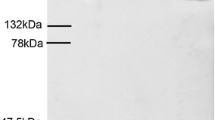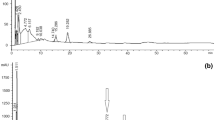Abstract
Vitellogenin (VTG) and choriogenin (CHO) are valuable biomarkers of endocrine-disrupting compound (EDC) exposure in fish. Existing immunoassays are limited to a few species, which restricts their use for the analysis of local wildlife sentinels. Using C. facetum as a relevant South American model fish, this work presents a new strategy for the preparation of antibodies to VTG and CHO, with zero cross-reactivity with fish serum components. Recombinant fragments of Cichlasoma facetum VTG (280-mer) and CHO (223-mer) were prepared by degenerate primer RT-PCR and expression in E. coli. Polyclonal and monoclonal antibodies prepared with these antigens were used to develop rapid dotblot assays for VTG and CHO. Both the polyclonal and monoclonal antibodies prepared with the recombinant antigens reacted against the native proteins adsorbed on to nitrocellulose allowing the set up of sensitive dotblot assays. The VTG assay was further validated with spiked samples and purified native VTG. Exposure experiments with several estrogenic compounds revealed the potential of C. facetum as a sensitive biomonitor that produced measurable responses at concentrations of 100 ng L−1 of 17-beta-estradiol, 100 ng L−1 of ethynylestradiol, and 6.6 μg L−1 of nonylphenol. The approach described here may be applied to other native species to produce highly specific and sensitive rapid tests. It may be particularly advantageous for species that cannot be kept in captivity or when homogeneous purification of the immunizing proteins is particularly challenging. In conclusion, we present a novel approach to develop a strategy for the generation of immunoassay reagents for vitellogenin (VTG) and choriogenin (CHO), which will facilitate regional studies on the impact of endocrine-disrupting chemicals on local wildlife.






Similar content being viewed by others
Abbreviations
- VTG:
-
vitellogenin
- CHO:
-
choriogenin
- EDC:
-
endocrine-disrupting compound
- (RT-)PCR:
-
(reverse transcription) polymerase chain reaction
- NP:
-
nonylphenol
- mAb:
-
monoclonal antibody
- ELISA:
-
enzyme-linked immunosorbent assay
- REP:
-
reported relative estrogenic potency
References
Arukwe A, Knudsen FR, Goksoyr A (1997) Environ Health Perspect 105:418–422
Choi KC, Jeung EB (2003) J Reprod Dev 49:337–345
Colborn T, vom Saal FS, Soto AM (1993) Environ Health Perspect 101:378–384
Fujita T, Fukada H, Shimizu M, Hiramatsu N, Hara A (2004) Gen Comp Endocrinol 136:49–57
Gasteiger E, Hoogland C, Gattiker A, Duvaud S, Wilkins MR, Appel R, Bairoch A (2005) Protein identification and analysis tools on the ExPASy server. In: Walker JM (ed) The proteomics protocols handbook. Humana Press, pp 573–609
Gonzalez G, Orn A, Cazzulo JJ, Gronvik KO (1994) Scand J Immunol 40:389–394
Hyllner SJ, Silversand C, Haux C (1994) Mol Reprod Dev 39:166–175
King ES (2006) Federal Register 71:9337–9339
Marin MG, Matozzo V (2004) Mar Pollut Bull 48:835–839
Murata K, Sugiyama H, Yasumasu S, Iuchi I, Yasumasu I, Yamagami K (1997) Proc Natl Acad Sci USA 94:2050–2055
Oppen-Berntsen DO, Gram-Jensen E, Walther BT (1992) J Endocrinol 135:293–302
Petrovic M, Eljarrat E, Lopez De Alda MJ, Barcelo D (2004) Anal Bioanal Chem 378:549–562
Petrovic M, Sole M, Lopez de Alda MJ, Barcelo D (2002) Environ Toxicol Chem 21:2146–2156
Rotchell JM, Ostrander KG (2003) J Toxicol Environ Health B 6:453–496
Routledge EJ, Sumpter JP (1997) J Biol Chem 272:3280–3288
Sumpter JP, Jobling S (1993) Lancet 342:124–125
Sumpter JP, Jobling S (1995) Environ Health Perspect 103(Suppl 7):173–178
Tyler CR, Jobling S, Sumpter JP (1998) Crit Rev Toxicol 28:319–361
Wahli W, Dawid IB, Ryffel GU, Weber R (1981) Science 212:298–304
Acknowledgments
National Institute of Health, Fogarty International Center (TW05718 -07). GN, NF, and MNM were pre-doctoral trainees supported by this training grant while these studies were being performed.
Author information
Authors and Affiliations
Corresponding author
Rights and permissions
About this article
Cite this article
Ferraz, N., Carnevia, D., Nande, G. et al. Specific immunoassays for endocrine disruptor monitoring using recombinant antigens cloned by degenerated primer PCR. Anal Bioanal Chem 389, 2195–2202 (2007). https://doi.org/10.1007/s00216-007-1630-3
Received:
Revised:
Accepted:
Published:
Issue Date:
DOI: https://doi.org/10.1007/s00216-007-1630-3




